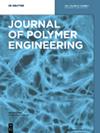Influence of CNTs on the gradient phase structure formed by the layered resin structure used to model the interlaminar region of interleaved FRPs
IF 1.7
4区 工程技术
Q4 POLYMER SCIENCE
引用次数: 0
Abstract
The interleaved fiber-reinforced polymer composites (FRPs) by carbon nanotubes (CNTs)/thermoplastic polyetherketone-cardo (PEK-C) hybrid interleaves show the potential of comprehensively improving the mechanical properties of composites and have been hotspot. However, the synergistic effect and mechanism of CNTs and TP resin have not been attained. The interlaminar region of interleaved composites is too narrow and complex to be fully analyzed. Therefore, the layered resin structure composed of an interlayer and a matrix (epoxy) layer was prepared to model the interlaminar region in this study. The evolution of gradient structure developed by the layered structure in curing and the influence of presence of CNTs in interlayer were investigated based on morphology characterization. The results showed that epoxy resin gradually diffused into the interlayer, resulting in the concentration gradient and the resultant gradient phase structure. The presence of CNTs in hybrid interlayer hindered the resin diffusion and consequently hindered the formation of dual-phase structure, which was not conducive to the toughness improvement. The inappropriate high temperature was not recommended due to the effect of facilitating diffusion, probably resulting in the formation of excrescent epoxy layer in the interlaminar region and undesired mechanical performance. This study conducted experiments on resin system to simplify the interesting subject and the results will help to develop the synergistic mechanism of TP resin and nanoparticles.CNT 对用于模拟交错玻璃钢层间区域的层状树脂结构所形成的梯度相结构的影响
碳纳米管(CNTs)/热塑性聚醚酮-卡多(PEK-C)混合交错纤维增强聚合物复合材料(FRPs)具有全面改善复合材料力学性能的潜力,一直是研究的热点。然而,CNTs 与 TP 树脂的协同效应和机理尚未得到研究。交错复合材料的层间区域过于狭窄和复杂,无法进行全面分析。因此,本研究制备了由中间层和基体(环氧树脂)层组成的层状树脂结构来模拟层间区域。基于形貌表征,研究了层状结构在固化过程中形成的梯度结构的演变,以及夹层中存在 CNTs 的影响。结果表明,环氧树脂逐渐扩散到夹层中,形成了浓度梯度和梯度相结构。混合夹层中 CNT 的存在阻碍了树脂的扩散,进而阻碍了双相结构的形成,不利于韧性的提高。由于促进扩散的作用,不建议使用不适当的高温,这很可能导致在层间区域形成脱落的环氧层,从而影响力学性能。本研究对树脂系统进行了实验,以简化这一有趣的课题,其结果将有助于发展 TP 树脂与纳米粒子的协同机制。
本文章由计算机程序翻译,如有差异,请以英文原文为准。
求助全文
约1分钟内获得全文
求助全文
来源期刊

Journal of Polymer Engineering
工程技术-高分子科学
CiteScore
3.20
自引率
5.00%
发文量
95
审稿时长
2.5 months
期刊介绍:
Journal of Polymer Engineering publishes reviews, original basic and applied research contributions as well as recent technological developments in polymer engineering. Polymer engineering is a strongly interdisciplinary field and papers published by the journal may span areas such as polymer physics, polymer processing and engineering of polymer-based materials and their applications. The editors and the publisher are committed to high quality standards and rapid handling of the peer review and publication processes.
 求助内容:
求助内容: 应助结果提醒方式:
应助结果提醒方式:


